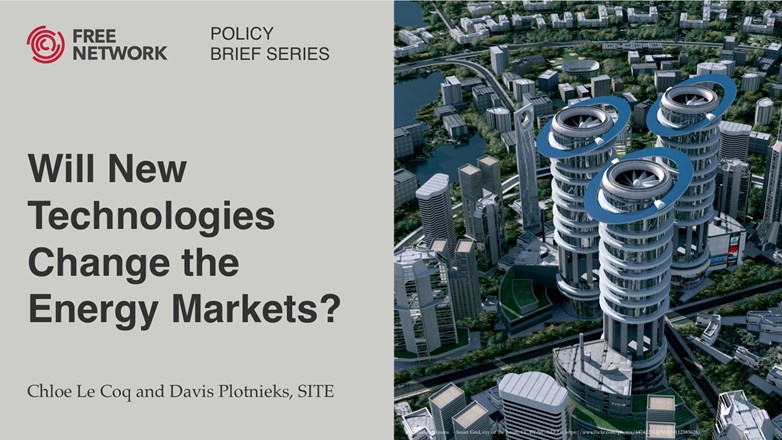Will new technologies change the energy markets?
With an increasing world demand for energy and a growing pressure to reduce carbon emissions to slow down global warming, there is a growing necessity to develop new technologies that would help addressing demand and carbon footprint issues. However, taking into account the world’s dependence on hydrocarbons the question remains – can new technologies actually change the energy markets?
The expanding world population and economic growth are considered the main drivers of the global energy demand. Up to 2040, total energy use is estimated to grow by 71% in developing countries and by 18% in the more mature energy-consuming OECD economies (IEA, 2016). In parallel, many countries (including the world’s biggest economies and largest emitters: USA and China) have signed the Paris agreement – the first-ever universal, legally binding global climate deal that aims to reduce emissions and to keep the increase in global average temperature from exceeding 2°C above pre-industrial levels.
Meeting a growing global energy demand, and at the same time reducing CO2 emissions, cannot be achieved by practicing ‘business as usual’. It will require some fundamental changes in the way economic activity is organized. In this context, the development of new technologies and how it will affect the energy sector is a crucial element.
Wind power, smart grid, and electromobility
With technological progress and support schemes to decrease CO2 emissions, wind energy is now a credible and competing alternative to energy produced from coal, gas and oil. In 2015, wind accounted for 44% of all new power installations in the 28 EU member states, covering 11.4% of Europe’s electricity needs (see here).
This new technology has triggered a downward pressure on energy prices because of a “Merit order effect” (i.e. a displacement of expensive generation with cheaper wind). While consumers may appreciate this development, Ewa Lazarczyk Carlson, Assistant professor at the Reykjavik University (School of Business) and IFN, stressed that the increasing importance of wind energy challenges the functioning of electricity exchange. First, a lower price has reduced the incentives to invest in conventional power plants necessary when the wind is not blowing or when it is dark. Moreover, with the renewable energy intermittency, the probability of system imbalance and price volatility has increased. In turn, this has led to an increase of maintenance costs for conventional generators due to their dynamic generation costs (i.e. start-ups and shut-down costs).
Digital technology has gradually been used in the energy sector during the last decades, changing the way energy is produced and distributed. With smart grid (i.e. an electricity distribution system that uses digital information) energy companies can price their products based on real time costs while customers have access to better information, allowing them to optimize their energy consumptions. Sergey Syntulskiy, Visiting Professor at the New Economic School in Moscow, stressed that smart grids have had at least two effects. They have made the integration of renewable energy to the system easier and have allowed for prosumers, i.e. entities that both consume and produce energy. The next step is to develop new regulatory incentives to optimize energy systems as well as to provide a legal framework for the exchange of information in the energy sector.
One of the main pollutants has long been the transport sector that accounts for 26% energy-related of CO2 emission (IEA, 2016). Electromobility – that is, use of electric vehicles – is often considered the solution for this problem. When this technology is widely adopted, a major switch from oil to electricity is expected for the transportation sector. Mattias Goldmann, CEO of Fores, argued that even if electromobility will improve air quality and reduce noise levels in cities, its positive impact relies on smart grids and locally produced energy. Moreover, the environmental benefits will be ensured only if electric energy is produced from renewable and clean sources.
Toward a carbon-neutral energy system?
The Nordic countries are currently pushing for a near carbon-neutral energy system in 2050. Markus Wråke, CEO at the Swedish Energy Research Centre, emphasized that the Nordic Carbon-Neutral Scenario is only feasible if new technologies allow for a significant change of energy sources and a better interconnected market (see report by IEA 2016 b).
To cut emissions, a decrease in oil and gas consumption in energy production and within the transport sector is needed (see Figure 1). The adoption of electric vehicles (EVs) and hybrid cars is very likely to drastically increase in the next decades (EVs may have a share of 60% of the passenger vehicle stock in 2050, IEA 2016b).
Figure 1. Nordic CO2 emissions in the CNS
There are currently limited technology options to reduce emissions for big industrial energy consumers. Moreover, there is a concern that those industries may choose to relocate if the Nordic emission standards are too strict. It is therefore important to have low and stable electricity prices. This can only be achieved if cross-border exchanges are improved (which means that the electricity trade in the Nordic region will have to increase 4-5 times by 2050). It is unclear however how policy makers will create a regulation that incentivizes energy companies to build interconnections and increase trade both between the Nordic countries, and the Western and Eastern European countries.
Figure 2. Electricity trade 2015 and 2050
Energy producers
Another concern is that energy-exporting and energy-importing countries may have opposing attitudes towards investing and developing new energy technologies. Countries among the biggest energy producers and exporters depend on a stable demand and price for energy. For example, Russian GDP growth depends between 50-92% on the oil price, depending on the variables used for calculations, as mentioned by Torbjörn Becker, Director of SITE. For large exporters of hydrocarbon, new energy technologies may be seen as a threat because of a potentially reduced energy demand and an increased price volatility that will, in turn, create fundamental issues to balance state budgets and improve living standards.
Figure 3. The Relationship between Russian GDP and oil price
 Source: Calculations by Torbjörn Becker, October 13, 2016
Source: Calculations by Torbjörn Becker, October 13, 2016
The challenge of security of supply
To summarize, new energy technologies will drive energy companies towards optimizations and cost cutting, bring previously unseen connectivity to energy markets and make energy markets more complex. Samuel Ciszuk, Principal Advisor at the Swedish Energy Agency, stressed that interconnected, more complex and interdependent energy systems might increase the vulnerability of energy systems to external threats and intimidates to decrease the security of supply. Technological change and increased competition with lower profit margins will force companies to minimize their expenditure on energy production, storage and transmission and to find cheaper financing options. Optimization and searches for cheaper financing instruments will push energy companies towards selling some of the company assets to financial investors. These changes will create a more decentralized energy market, with more players. Such energy systems will become harder to govern in times of an energy crisis and external threats. Policy makers will have to design new and more complex regulations to fit the needs of the transforming energy markets.
References
- Fogelberg, Sara and Ewa Lazarczyk, 2015. “Wind Power Volatility and the Impact on Failure Rates in the Nordic Electricity Market”, IFN Working Paper 1065.
- IEA, Annual Energy Outlook, 2016a.
- IEA/OECD/Norden, 2016b. “Nordic Energy Technology Perspectives” (see here)
- Speaker presentation from the 10th Energy day, 2016 (see here)






